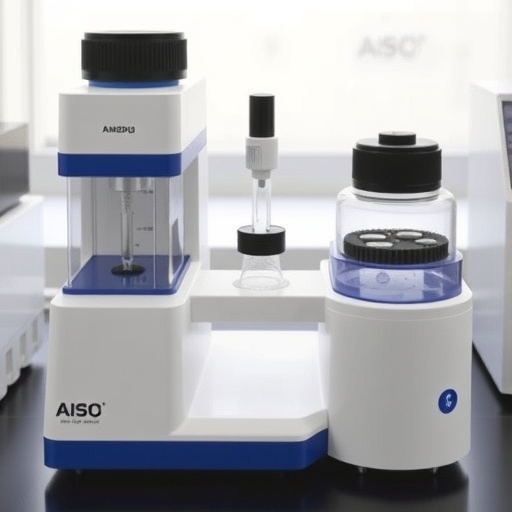In a groundbreaking study published in BMC Pharmacology & Toxicology, researchers from China have developed a novel ultra-performance liquid chromatography tandem mass spectrometry (UPLC-MS/MS) method that represents a significant advancement in the quantification of asciminib, a promising drug in the realm of oncology. The innovative approach not only enhances the precision and accuracy of asciminib measurement in biological samples but also elucidates its pharmacokinetic interactions and metabolic stability when combined with shikonin, a traditionally used compound derived from the root of the Lithospermum erythrorhizon plant.
Asciminib has gained recognition for its ability to selectively target BCR-ABL1, a critical protein implicated in various leukemias. This specificity highlights the need for robust analytical techniques that can precisely determine asciminib concentrations in biological matrices. The UPLC-MS/MS technique employed by these researchers stands out due to its rapid analysis time, sensitivity, and the ability to analyze multiple compounds simultaneously, paving the way for better therapeutic monitoring and individualized treatment strategies for cancer patients.
The meticulous process began with the optimization of the UPLC-MS/MS conditions to ensure the highest sensitivity for asciminib. The researchers adjusted parameters such as mobile phase composition, flow rate, and column temperature to fine-tune the equipment for optimal performance. Rigorous validation studies were conducted to assess parameters such as linearity, accuracy, precision, and recovery rates. These validation parameters are critical for confirming that the method meets rigorous scientific standards, rendering it suitable for clinical and research applications.
One notable aspect of their research was the examination of asciminib’s pharmacokinetics—how the drug is absorbed, distributed, metabolized, and excreted in the body. Through careful experimentation, the researchers established key pharmacokinetic parameters that are vital for understanding the drug’s behavior within the complex biological environment. This data provides essential insights into dosing regimens and potential drug interactions, particularly when used in conjunction with herbal medicine or other therapeutic agents.
Shikonin, the other compound investigated in this study, has a rich history in traditional medicine and is commonly recognized for its anti-inflammatory and antioxidant properties. However, the interaction of shikonin with synthetic drugs like asciminib could complicate treatment protocols. The researchers conducted in vitro experiments to assess the metabolic pathways and interactions between asciminib and shikonin. Understanding these interactions is crucial; it can reveal potential changes in the efficacy and safety of asciminib treatment when used alongside herbal remedies.
The study’s findings are particularly relevant in the context of personalized medicine, where understanding individual responses to medications is becoming increasingly important. This research contributes to the growing body of knowledge regarding how traditional remedies may affect innovative therapeutic agents, shedding light on the potential for drug-drug interactions that could lead to adverse effects or reduced efficacy. By meticulously examining these interactions, the researchers aim to provide clearer guidance for clinicians who are navigating complex treatment regimens that incorporate both modern and traditional medicinal approaches.
Moreover, the implications of this work extend beyond asciminib and shikonin. The methodologies established herein may serve as a reference framework for future studies investigating other drugs and their interactions with natural compounds. As the pharmaceutical landscape continues to evolve, the need for effective analytical tools becomes paramount, especially in the era of multi-modal therapeutic approaches.
The researchers also stressed the importance of ongoing research in pharmacokinetics and drug interactions, especially in populations that utilize complementary and alternative medicine. The integration of these therapeutic modalities into everyday healthcare necessitates a scientific foundation to ensure patient safety and treatment effectiveness. By emphasizing the need for rigorous drug evaluation and the importance of understanding herb-drug interactions, the study paves the way for safer clinical practices.
The publication of this research could lead to broader discussions within the scientific community regarding the need for improved methodologies in drug evaluation. As researchers continue to uncover the complexities of drug interactions, the importance of cross-disciplinary collaboration becomes apparent. By bridging the gap between pharmacology, toxicology, and traditional medicine, scientists can foster a more holistic understanding of health and disease management.
In conclusion, the development and validation of a UPLC-MS/MS method for quantifying asciminib while examining its interactions with shikonin represents a significant stride in the fields of pharmacology and toxicology. This study not only enhances our understanding of asciminib’s pharmacokinetics but also adds critical knowledge about the implications of combining synthetic and traditional medicines. The continuous exploration of these dimensions will undoubtedly inspire future research and innovation, ensuring that patients receive the most effective and safe treatments available today.
In an era where the distinction between conventional and traditional medicine is blurring, research such as this is vital in guiding clinicians and researchers alike in the quest to improve patient outcomes, all while acknowledging the historical context and scientific basis of therapies in use today. The dialogue between modern science and traditional wisdom continues to deepen, promising a future where integrative approaches become the norm in healthcare.
Subject of Research: Quantification of asciminib and its pharmacokinetic interaction with shikonin.
Article Title: Development and validation of a UPLC-MS/MS method for the quantification of asciminib and its pharmacokinetic interaction and metabolic stability with shikonin.
Article References:
Zhou, C., Xia, H., Hu, Y. et al. Development and validation of a UPLC-MS/MS method for the quantification of asciminib and its pharmacokinetic interaction and metabolic stability with shikonin.
BMC Pharmacol Toxicol (2025). https://doi.org/10.1186/s40360-025-01049-0
Image Credits: AI Generated
DOI: 10.1186/s40360-025-01049-0
Keywords: asciminib, UPLC-MS/MS, pharmacokinetics, shikonin, drug interactions, traditional medicine, therapeutic monitoring.
Tags: advanced mass spectrometry applicationsasciminib quantification in oncologyBCR-ABL1 targeting drugsbiological sample analysis methodscancer treatment monitoring techniquesdrug metabolism studiesliquid chromatography in drug analysisoptimization of analytical conditionspharmacokinetic interactions of asciminibprecision medicine in cancer therapyshikonin analysis techniquesUPLC-MS/MS method development





